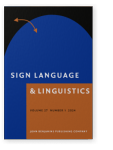Vol. 27:1 (2024) ► pp.35–72
Noun classifiers in Hong Kong Sign Language
As most other sign languages, Hong Kong Sign Language (HKSL) makes use of verbal classifiers for the purpose of spatial predication. However, a thorough study of the Asian SignBank shows that these same classifier handshapes occur in 76% of all HKSL nouns. In this paper, I argue that these classifier handshapes embedded in nouns are in fact noun classifiers. Under the framework of Distributed Morphology, classifier handshapes are underspecified roots in root compounds which can be assigned the nominal category when merged with a nominal functional head in syntax. The function of these classifiers is to identify, and categorize a discourse referent, and they are full-fledged classifiers according to standards set by the general linguistic literature on classifiers. In addition to verbal and noun classifiers, I also briefly show how HKSL uses mensural numeral classifiers to intervene between mass nouns and numerals within the NP. Taken together, this means that HKSL employs three different types of classifiers: verbal, noun, and numeral classifiers.
Article outline
- 1.Introduction
- 2.Spoken and sign language classifiers
- 2.1Numeral classifiers
- 2.2Verbal classifiers
- 2.3Noun classifiers
- 2.4Perspectives on classifier handshapes occurring in nouns
- 2.4.1 Schembri (1996): Lexicalization
- 2.4.2Accounts on Swedish Sign Language and Hungarian Sign Language
- 2.4.3The issue of precedency
- 2.5Interim summary
- 3.HKSL noun classifiers
- 3.1Methodology
- 3.2HKSL data
- 3.2.1Compound signs
- 3.2.2Nouns without classifiers
- 3.2.3Productivity
- 3.3Classification and agreement
- 3.2HKSL data
- 4.A DM perspective on HKSL noun classifiers
- 4.1Introduction to Distributed Morphology
- 4.2Zwitserlood’s (2003, 2008) account of NGT classifier handshapes
- 4.3A DM account of HKSL noun classifiers
- 3.1Methodology
- 5.Discussion
- 5.1A third type of classifier: Numeral classifiers
- 5.2A typological perspective on HKSL classifiers
- 6.Concluding remarks
- Acknowledgements
- Notes
-
References
